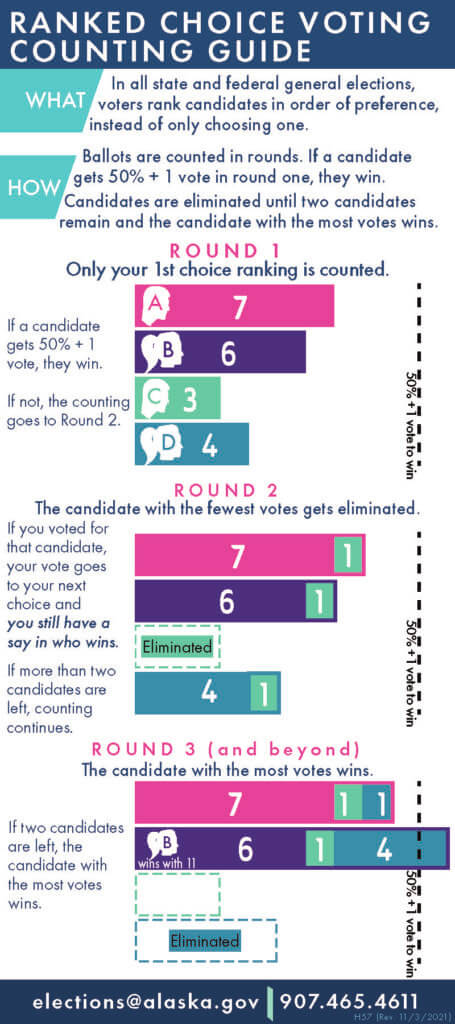GENERAL ELECTION IS TUESDAY, NOVEMBER 5TH
The 2024 General Election will take place Tuesday, November 5th. Alaskans will cast their votes for the US President/Vice-President, US Representative, Senate Representative and House Representative, Supreme Court judges, and on two ballot initiatives.
Voter Registration
Check your Voter Registration Status.
Find Your Polling Location
Find out where to vote based on you city and district.
Follow Us
Follow Interior Native Vote on Social Media.
What will be on my ballot?
You can also visit the Alaska Division of Elections to view a sample ballot.
Ballot Measure No. 1
This measure would raise Alaska’s minimum wage to $13 in 2025, $14 in 2026, and $15 in 2027, with further increases tied to inflation. It would also require employers to provide paid sick leave and prevent mandatory meetings about religious or political topics. A “Yes” vote supports these changes, while a “No” vote keeps current laws in place.
Ballot Measure No. 2
This measure would end ranked-choice voting and open primaries, returning to party-based primaries and single-choice general elections, as they were before 2022. A “Yes” vote restores the previous election system, while a “No” vote keeps the current system.
Kamala Harris
Democratic Nominee
Running Mate: Tim Walz, Minnesota Governor
Donald Trump
Republican Nominee
Running Mate: JD Vance, US Senator of Ohio
Nick Begich (R)
Mary S. Peltola (D)
John Howe (I)
Eric Hafner (D
DISTRICT P
Leslie Hajdukovich (R)
Scott Kawasaki (D)
DISTRICT R
Mike Cronk (R)
Savannah Fletcher (U)
Robert ‘Bert’ Williams (I)
DISTRICT 31
Maxine Dibert (D)
Bart LeBon (R)
DISTRICT 32
Gary K. Damron (D)
Will Stapp (R)
DISTRICT 33
Glenn ‘Mike Prax (R)
DISTRICT 34
Joy ‘Joy Beth’ Cottle (R)
Frank Tomaszewski (R)
DISTRICT 35
Ashley E. Carrick (D)
Ruben McNeill Jr. (R)
DISTRICT 36
James Fields (L)
Pamela Goode (R)
Brandon Putuuqti Kowalski (D)
Rebecca Shwanke (R)
Marjorie K. Allard
Court of Appeals
Statewide
Dario Borghesan
AK Supreme Court
Statewide
Patricia L. Haines
Fairbanks Superior Court
Fourth Judicial District
Timothy W. Terrel
Court of Appeals
Statewide
Maria Pia L. Bahr
Fairbanks District Court
Fourth Judicial District
Matthew Christian
Fairbanks District Court
Fourth Judicial District
Jennifer Stuart Henderson
AK Supreme Court
Statewide
GET TO KNOW YOUR CANDIDATES
Select on of the questions below to find out how you candidates answered!
SOURCE: Alaska Beacon
Education
What do you think should be done to improve public education in the state?
Fishing
What, if any, change would you make to state law to support the fishing industry and Alaskans who are dependent on fish harvests?
PFD
How should the state set the amount of the Permanent Fund dividend each year?
Energy
What should be done to address the pending energy crunch along the Railbelt?
Party Differences
How would you work with legislators of different political parties to get things done in the Legislature?
Public Employees
What should the state do to improve retention of public employees, including teachers?
Tribal-State Relations
How and where should the state work with tribal governments?
Budget Cuts/Revenues
When you look at the state budget, what’s the No. 1 thing you’d like to see cut or reduced, and what’s your No. 1 preferred way to raise new state revenue?
Health
What should the state do to safeguard and improve Alaskans’ health?
Biggest Need
What’s the biggest need in your district, and how would you address it?
Elections and Voting
What, if any, changes does the state need to make to its elections and voting system?
Oil
How long will oil be central to Alaska’s economy, and what, if anything, should the state government be doing now to prepare for a post-oil future?
Population
What, if anything, would you like to do to address Alaska’s dwindling working-age population?
Ballot Measures
What do you think of this year’s ballot measures, and do you intend to support or oppose them?
Domestic Violence
How would you like to see the state address Alaska’s high rates of domestic and sexual violence?
Ranked Choice Voting
Ranked Choice Voting allows voters to rank candidates in order of preference. In all state and federal elections, voters rank candidates in order of preference, instead of only choosing one.
- Rank the candidates you like in order of preference.
- Your favorite is your first choice.
- Ranking other candidates doesn’t affect your first choice.
- If a candidate receives a majority of first-choice votes (50%+1), they win. If no candidate receives a majority, the candidate with the fewest votes is eliminated and voters that ranked that candidate first have their vote counted for their next choice.
- This process continues until one candidate receives a majority of voters’ choices.
Learn more about ranked choice voting in the General Election here: Election Information – Division of Elections (alaska.gov)

